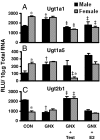Mechanism of gender-divergent UDP-glucuronosyltransferase mRNA expression in mouse liver and kidney
- PMID: 19131521
- PMCID: PMC2680534
- DOI: 10.1124/dmd.108.024224
Mechanism of gender-divergent UDP-glucuronosyltransferase mRNA expression in mouse liver and kidney
Abstract
UDP-glucuronosyltransferases (UGTs) catalyze the addition of glucuronic acid to endo- and xenobiotics, increasing hydrophilicity and enhancing elimination. Gender-divergent glucuronidation rates are observed in humans and rats, and gender differences in UGT mRNA levels have been observed in rodents. The purpose of this study was to establish the hormonal regulation of gender-dependent Ugt mRNA expression in mouse liver and kidney. Therefore, three mouse models were used to characterize the involvement of sex hormones and gender-specific growth hormone (GH) secretion patterns, including 1) hypophysectomized mice treated with male- or female-pattern GH, testosterone, or 17beta-estradiol; 2) GH releasing hormone receptor-deficient little (lit/lit) mice treated with male- or female-pattern GH; and 3) gonadectomized mice treated with testosterone or 17beta-estradiol. Messenger RNA expression of mouse Ugt isozymes was determined by the branched DNA assay. In C57BL/6 mice, male-predominant expression of Ugt2b1 and Ugt2b38 was observed in liver and kidney, respectively. Female-predominant expression was observed for Ugt1a1 and Ugt1a5 in liver and Ugt1a2 in kidney. In liver, regulation of Ugt1a1 and Ugt1a5 expression was attributed to repression of Ugt mRNA by male-pattern GH secretion. Conversely, regulation of Ugt2b1 expression in liver was attributed to male-pattern GH secretion. In kidney, regulation of Ugt2b38 expression was attributed to inductive effects by testosterone. Conversely, Ugt1a2 expression in kidney was negatively regulated by testosterone. In conclusion, gender differences in mouse Ugt mRNA expression were influenced by male-pattern GH secretion in liver, whereas gender differences were regulated by the effects of androgens in kidney.
Figures







References
-
- Anderson GD (2002) Sex differences in drug metabolism: cytochrome P-450 and uridine diphosphate glucuronosyltransferase. J Gend Specif Med 5 25–33. - PubMed
-
- Buckley DB and Klaassen CD (2007) Tissue- and gender-specific mRNA expression of UDP-glucuronosyltransferases (UGTs) in mice. Drug Metab Dispos 35 121–127. - PubMed
-
- Buist SC, Cherrington NJ, and Klaassen CD (2003) Endocrine regulation of rat organic anion transporters. Drug Metab Dispos 31 559–564. - PubMed
-
- Buist SC and Klaassen CD (2004) Rat and mouse differences in gender-predominant expression of organic anion transporter (Oat1–3; Slc22a6–8) mRNA levels. Drug Metab Dispos 32 620–625. - PubMed
-
- Burchell B, Brierley CH, and Rance D (1995) Specificity of human UDP-glucuronosyltransferases and xenobiotic glucuronidation. Life Sci 57 1819–1831. - PubMed
Publication types
MeSH terms
Substances
Grants and funding
LinkOut - more resources
Full Text Sources

